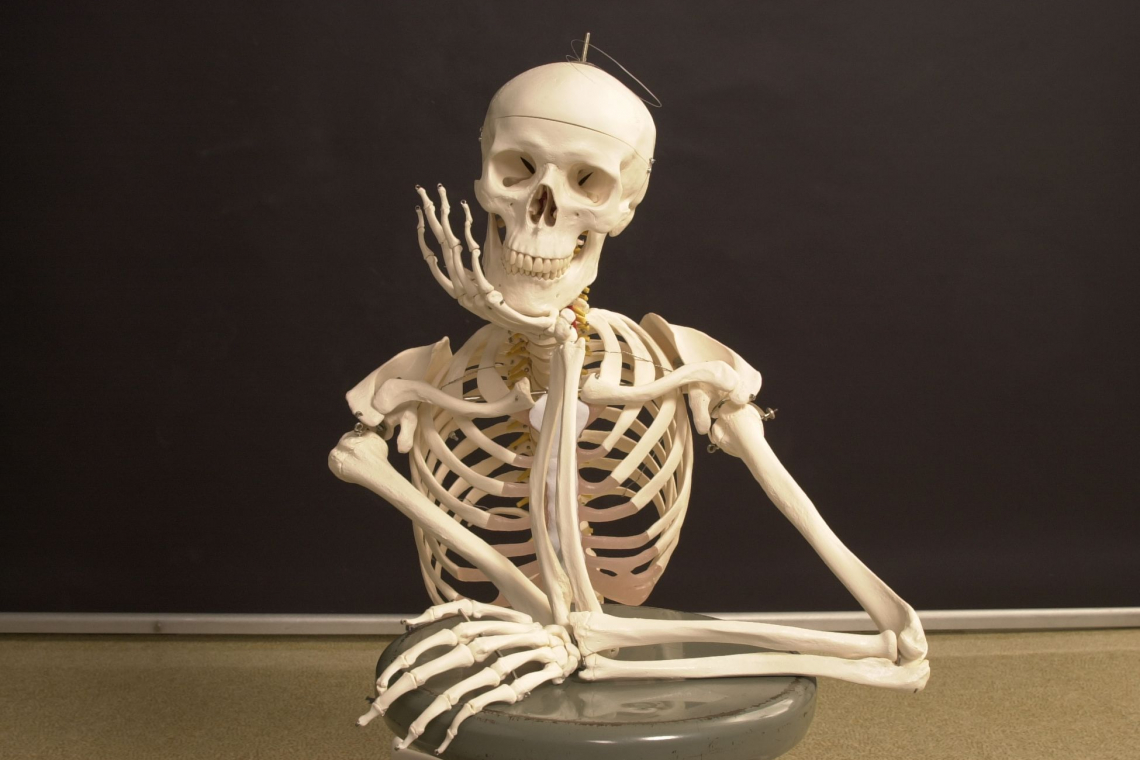Author: Colin Michie FRCPCH FRSPH FLS
Bones are not just quiet, inert mineral girders from which the rest of our body hangs. They do not just help you gyrate with grace on the dance floor. They are part of your daily activities in more ways than you might imagine. In three quarters of a billion years of vertebrate evolution, our bones have become sophisticated, dynamic, elegant, metabolic machines. Unlike jellyfish, we can grit our teeth and dig in our heels!
Bones contain marrow, creative nests for your blood’s stem cells. These make red cells, platelets and many of your white cells too. Bones store energy in the form of fat, which is why marrow fat was such a prized food until the last century, and still is among hunter/gatherer communities. Bones contain over 98% of your body calcium, most of your phosphorous, magnesium and fluoride. All these are also used by your nervous system, which calls routinely upon your bone bank. And bone marrow remembers too – it makes niches for memory B lymphocytes that recall that you suffered with influenza, or were vaccinated against tetanus. They wait there, ready to supply protective antibodies when required.
Bone crushers – whether pugilists, racehorses, vultures, medieval clubs, orcs or transformers – are powerful, action-packed and busy. Bones are where physical responses happen. So perhaps you are trying out a paddle board in a calm turquoise bay, when you see a shark fin in the water just a few meters away. Or perhaps your bicycle brake cable shears off when you are whizzing down Cay Hill into traffic. These would cause most of us some fear. Adrenaline pumps, we sweat, heart rate increases. Blood sugars rise, muscles charge into action! Responses to stress are choreographed by bone hormones, osteocalcin in particular, as well as adrenaline, to mobilise glucose. Bones use glucose, along with the brain, heart and muscles. Osteocalcin improves bone strength, memory and testosterone production too.
We all suffer with aches and discomforts. Slept in the wrong position? Tripped over that step outside? Pains after jumping out of a car? We like to blame our skeletons for these problems, but bones are usually innocent. Troubling pains more often come from inflamed joint linings, or tendons and their lubrication systems. Bones are remarkably good at weight-bearing, at responding to muscle activities, delivering mobility, physical skills, agility. Bones of your legs and spine remodel daily in response to your activities.
Problems develop when you do not use your skeleton. It does not take kindly to the tyrannies of the sofa, even less to leaving gravity and visiting space. Bone needs to be used, it needs those stress reactions. The unemployed skeleton loses its minerals, its reinforcing microarchitectures. Osteoporosis, the loss of bone mineral mass, is the most common bone disease in humans. It is silent, painless and dangerous. It is four times more common in women after their menopause and is probably the most disabling effect of ageing in women. Thinning bones are liable to fracture. Fractures are costly and often life-changing.
Have you lost height over the last few years? This can be a sign of early osteoporosis in your vertebrae. Bone in the spine, as well as in femurs, readily fractures if osteoporotic. Lost a tooth? This might follow osteoporosis in the jaw. A screen to estimate your risk of osteoporosis is available online at: https://riskcheck.osteoporosis.foundation/#:~:text=The IOF Osteoporosis Risk check is intended as a diagnostic tool: only a doctor can diagnose osteoporosis. If the result of this concerns you, plan an appointment with a doctor.
Orthopaedic treatments have made amazing advances, with replacement hips and knees, bone grafts, scaffolding systems, rods, plates and 3D-printed implants (including spinal) all on the menu. But keeping bones strong and avoiding fractures should allow you to carefully avoid such pricey surgical approaches!
Illness, age, family histories and low physical activity contribute to osteoporosis. Weak bones in turn challenge balance and mobility. We all need to exercise – regularly. This is time well spent. Consult Desiree’s articles in The Daily Herald. Take up Tai Chi. Get back dancing. Diets for healthy bones are important too: bone requires calcium, phosphorus, magnesium, vitamins A, C and D. These are usually available in a healthy diet, although vitamin D can be a problem for those living without St. Martin’s tropical sunshine. Diets containing seeds, teas and soya may be useful for some women. There are medical treatments for osteoporosis, using bisphosphonates for example, that prevent fractures. These require careful monitoring by a doctor.
Active lifestyles, safe homes without risks for falls and sensible eating are positive strategies to maintain bone integrity. So check on your grandparents, and measure your own height too. Your quiet collection of over 200 bones needs cultivation, to be kept in good shape, not just for Halloween but all year round.
Useful resources:
https://caribbeanarthritisfoundation.org/en/osteoporosis/
https://www.nhs.uk/conditions/osteoporosis/







